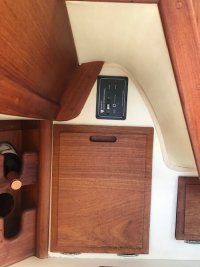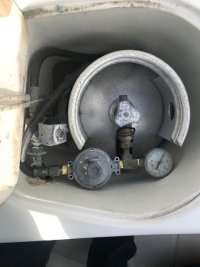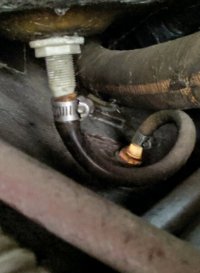You are using an out of date browser. It may not display this or other websites correctly.
You should upgrade or use an alternative browser.
You should upgrade or use an alternative browser.
Survey: E35-3 Propane Control Panel Location
- Thread starter MarineCityBrian
- Start date
The pressure gauge can't tell you how much propane is left because propane in your tank is stored as a liquid - only a small amount of it is in the vapor phase and more evaporates from the liquid as you use it. Some tanks have a liquid level indicator and with the composite tanks, you can visually see the liquid level. The pressure gauge can tell you if you have "some" propane left or "none," but no information in between.
The most important use of the pressure gauge is to test for leaks in the system. With all of your appliances turned off and the tank valve turned off, pressure should remain constant. If it starts dropping, you have a leak somewhere.
The most important use of the pressure gauge is to test for leaks in the system. With all of your appliances turned off and the tank valve turned off, pressure should remain constant. If it starts dropping, you have a leak somewhere.
MarineCityBrian
Apprentice Tinkerer
All - GREAT photos! Thanks for contributing! These should help anyone looking to either upgrade or outfit their boat with LPG, or upgrade their existing LPG setup.
Looks like Christian has the new style tank connector, and I do like the idea of having some of the bits hard mounted with a high pressure pigtail, though if a leak in that hose ever occurred, that wouldn't be good. Some of the other setups with the solenoid, regulator and tank connector all on the same hard fitting may have the benefit of a lower likelihood of an unregulated hose breakage. But from what I've seen (other than the lack of gauge) all of these abide by ABYC guidelines.
In regards to sniffer, my shut-off unit doubles as a sniffer, and came with the stove, so I'm merely installing it since that's what I've got.

ABYC requires a shut-off within proximity to the appliance. My DC panel also has a "stove" switch (or it might be "oven" or "range"... I can't quite recall...) which would provide power to the sniffer/valve control, and manipulating either switch to off would shut off the propane valve.
On the locker drains, I'll try to snap a photo of mine below the cockpit (I'll caution you that firstly it will be much dirtier...) some time this weekend. I don't recall having that S-bend which seems to be causing you drainage trouble. If I recall it's a fairly straight shot out. Only issue I see there is in a following sea waves slapping against the underside of the overhang may enter more easily than if an S-bend were present. But then again when are you cooking during any substantial following sea?
Looks like Christian has the new style tank connector, and I do like the idea of having some of the bits hard mounted with a high pressure pigtail, though if a leak in that hose ever occurred, that wouldn't be good. Some of the other setups with the solenoid, regulator and tank connector all on the same hard fitting may have the benefit of a lower likelihood of an unregulated hose breakage. But from what I've seen (other than the lack of gauge) all of these abide by ABYC guidelines.
In regards to sniffer, my shut-off unit doubles as a sniffer, and came with the stove, so I'm merely installing it since that's what I've got.

ABYC requires a shut-off within proximity to the appliance. My DC panel also has a "stove" switch (or it might be "oven" or "range"... I can't quite recall...) which would provide power to the sniffer/valve control, and manipulating either switch to off would shut off the propane valve.
On the locker drains, I'll try to snap a photo of mine below the cockpit (I'll caution you that firstly it will be much dirtier...) some time this weekend. I don't recall having that S-bend which seems to be causing you drainage trouble. If I recall it's a fairly straight shot out. Only issue I see there is in a following sea waves slapping against the underside of the overhang may enter more easily than if an S-bend were present. But then again when are you cooking during any substantial following sea?
Last edited:
ABYC requires a shut-off within proximity to the appliance.
Ah, that explains why the electrical panel "stove" breaker isn't sufficient.
Ah, that explains why the electrical panel "stove" breaker isn't sufficient.
Scratches head... But what if you have two different appliances on opposite sides of the boat? Oh well. My boat probably isn't big enough to have non-proximate areas. I could probably reach the breaker on the main panel with one step from the furnace.
Scratches head... But what if you have two different appliances on opposite sides of the boat? Oh well. My boat probably isn't big enough to have non-proximate areas. I could probably reach the breaker on the main panel with one step from the furnace.
Standards may have changed since I did a full install of a system on our prior boat. I had a remote shut off for the solenoid valve in the compartment with the tank, and a sniffer by the cabin sole in the main cabin near the galley. There was a manifold in the tank compartment with a separate hose exiting to go forward to the countertop cooker and the other hose went to the "Cozy Cabin Heater."
The sniffer alarm and the electrical control for the solenoid were in a small panel mounted inside the boat adjacent to the entry.
I did "test" the sniffer module occasionally by holding a portable propane tank just off the bbq on the stern rail. There was always a tiny bit of gas around the top of the canister after being unscrewed from the bbq and that was enough to provoke a squawk from the alarm.
We enjoyed having LPG for heating and cooking, but were always a bit paranoid about it... We once visited a larger boat the day after the deck was blown off by an explosion. Not a sight you ever really forget.
MarineCityBrian
Apprentice Tinkerer
ABYC's verbiage:
"1.8.1 - A readily accessible manual or electrically operated (solenoid) shut-off valve shall be installed in the low or high pressure line at the fuel supply (see A-1.12 for valve location), The valve(s) or its control must be operable from the vicinity of the appliance(s) in the event of a fire at any appliance(s), If the cylinder valve is readily accessible from the vicinity of the appliance, the shut-off valve on the supply line is not required."
I'm sure the argument could be made that our DC Panels are within the vicinity of the appliance for most locations within the main cabin, but manufacturer precedence puts a shut off right nearby the stove.
"1.8.1 - A readily accessible manual or electrically operated (solenoid) shut-off valve shall be installed in the low or high pressure line at the fuel supply (see A-1.12 for valve location), The valve(s) or its control must be operable from the vicinity of the appliance(s) in the event of a fire at any appliance(s), If the cylinder valve is readily accessible from the vicinity of the appliance, the shut-off valve on the supply line is not required."
I'm sure the argument could be made that our DC Panels are within the vicinity of the appliance for most locations within the main cabin, but manufacturer precedence puts a shut off right nearby the stove.
Last edited:
Kevin A Wright
Member III
It looks like a factory installation. I don't know why a separate solenoid switch was required, or why the stock panel "stove" breaker wouldn't suffice. (I have to turn them both on).
Anybody know?
Christian, I was just down on the boat and noticed that my sniffer panel was mounted on a wood panel affixed to the bulkhead. I now think I probably the original configuration was just what you have. And when they added the sniffer on mine they had to add a wood panel behind it since the sniffer is smaller than what you are showing - in other words they had to cover the hole from the original install.
Now that still doesn't explain why you need two panels one step away from each other to turn off a solenoid. That is the sort of question that requires a fair amount of bourbon to properly contemplate, so I'll put it on the back shelf for now.
Kevin Wright
E35 Hydro Therapy
MarineCityBrian
Apprentice Tinkerer
My propane drain is pretty curly-cued; perhaps moreso than yours... And much dirtier....
View attachment 27267
Yeah, that's what mine looked like before I replaced the old sticky vinyl with the reinforced water hose. If water still drains out, there's probably no reason to change it. There was a lot of that vinyl hose in my boat. The water tank vent hoses were that same stuff until I changed them. Thanks for the picture.
I asked the question about water blocking propane from exiting the locker drain hose if there was a leaky joint or valve in the locker. I am still not completely sure, but I think the answer is "Yes, the water will block the propane from exiting the locker." I did some research this evening.
The key is the density of the two fluids. Water density is 997 kg/m3 (kg per cubic meter) and liquid propane is just 493 kg/m3. (Edit: I should have used the gaseous state density of propane, which is 1.875 kg/m3 at 15 deg C and 1 bar pressure) That should mean that propane gas will float on top of water. If you think about motor oil and water, and the fact that oil floats on water, it makes sense. if you pour a cup of water into a gallon of 5W-30 motor oil (860 kg/m3), the water finds it's way to the bottom since water is denser than oil. Same reason that water goes to the bottom of our boat and auto fuel tanks. Diesel fuel and gasoline are both less dense than water.
But what happens to that propane that can't escape the locker through the drain? Well, it will eventually fill the locker, unless there is a hole higher up in the locker that … dumps it into the lazarette. If the propane does overtop the locker it drains into the cockpit on my boat. And it goes out the cockpit drain above the water line … as long as there is no water trapped in the cockpit drain hoses down in the nest behind the water heater.
Food for thought.
Last edited:
While closing up the boat the other day I noticed that the propane bottle valve was open (not the solenoid, the physical valve).
Hmmm. Probably open for a month.
So: When cooking aboard, the food for thought afterwards should be a hard chew on the last and most important menu item, namely:
Confirmation that the propane source has been shut off.
Hmmm. Probably open for a month.
So: When cooking aboard, the food for thought afterwards should be a hard chew on the last and most important menu item, namely:
Confirmation that the propane source has been shut off.
MarineCityBrian
Apprentice Tinkerer
I asked the question about water blocking propane from exiting the locker drain hose if there was a leaky joint or valve in the locker. I am still not completely sure, but I think the answer is "Yes, the water will block the propane from exiting the locker." I did some research this evening.
The key is the density of the two fluids. Water density is 997 kg/m3 (kg per cubic meter) and propane is just 493 kg/m3. That should mean that propane gas will float on top of water. If you think about motor oil and water, and the fact that oil floats on water, it makes sense. if you pour a cup of water into a gallon of 5W-30 motor oil (860 kg/m3), the water finds it's way to the bottom since water is denser than oil. Same reason that water goes to the bottom of our boat and auto fuel tanks. Diesel fuel and gasoline are both less dense than water.
But what happens to that propane that can't escape the locker through the drain? Well, it will eventually fill the locker, unless there is a hole higher up in the locker that … dumps it into the lazarette. If the propane does overtop the locker it drains into the cockpit on my boat. And it goes out the cockpit drain above the water line … as long as there is no water trapped in the cockpit drain hoses down in the nest behind the water heater.
Food for thought.
The propane will leave the locker as soon as the mass of the propane exceeds that of the water left in the 'trap'. It may still leave a little left in the locker but not much (again, roughly the same amount mass-wise as the water keeping it from exiting the hose).
As for a solution (ridding the system of the "drain trap"), I'd think one could use a 90 degree thru hull drain fitting for the bottom of the locker. That should allow the tubing to flow only down-hill to the straight thru-hull that goes through the overhang. Probably not a project for me this season, but I'd also like to get rid of those nasty sticky old vinyl hoses at some point, and may consider that upgrade at that time.
The propane will leave the locker as soon as the mass of the propane exceeds that of the water left in the 'trap'. .
Yeah, I thought about that too. But the density Craig quoted for propane is for the liquid. At atmospheric pressure (I.e. an unsealed propane locker) only gaseous propane will be leaking out. Propane gas is only 1.5 times denser than air, so it's not going to be displacing water out of an elevated tube.
Last edited:
If our box is truly sealed, except for the vent, any gas expelled will eventually build up enough pressure to bubble out through a P trap.
In my experience, minor leaks from fittings are about equal to minor leaks out through the lid and make no difference. Remember, the output pressure of a propane regulator is only about 0.4 psi. OTOH, Regulator failure, which I have seen three or four times, creates a lot of pressure in a hurry, and will blow any water out of the trap like spit through a trumpet.
In my experience, minor leaks from fittings are about equal to minor leaks out through the lid and make no difference. Remember, the output pressure of a propane regulator is only about 0.4 psi. OTOH, Regulator failure, which I have seen three or four times, creates a lot of pressure in a hurry, and will blow any water out of the trap like spit through a trumpet.
Last edited:



